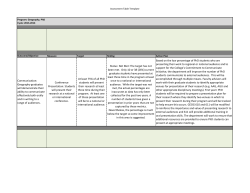
For more information go to http://ed560.ipgp.fr, section: Offres de
Subject offered for a contract starting october 2015 SUBJECT TITTLE: Characterizing submarine active faults in different geodynamic settings: Implications for seismic and tsunami hazard Advisor: ESCARTIN, Javier (DR CNRS), escartin@ipgp.fr Second Advisor/ Supervisor: FEUILLET, Nathalie (PA IPGP), email address Host lab/ Team : IPGP- Geosciences Marines & Tectonique– UMR7154 Financing: Doctoral contract with or without assignment. For more information go to http://ed560.ipgp.fr, section: Offres de these (PhD offer), You must apply on the Doctoral School website Seismic hazard evaluation requires field observations, with the characterization of fault ruptures on the Earth’s surface, fault geometry, and their evolution in time. These observations are common on-land, and have informed us about the behavior of faults and facilitated the modeling of deformation mechanisms in the crust. In the marine environment seismic risk is enhanced by that of tsunamis triggered by earthquakes or associated mass-wasting processes. At the same time, and when compared with subaerial environments, observations at the seafloor are scarce and limited as they require the deployment of deep-sea vehicles such as remotely operated or autonomous vehicles (ROVs and AUVs, respectively). The topic of this Thesis is the study of fine-scale seafloor topography to investigate the morphology of active submarine faults in order to characterize both the recent deformation of the seafloor associated with the last earthquake(s) and the long-term deformation expressed through the cumulative scarp. The integration of long-term and short-term observations is key to document and quantify important submarine processes (erosion, sedimentation, mass-wasting, etc) as well as to better understand the seismic cycle of the submarine faults and estimate their seismic hazard. Here we propose the study of both normal and strike-slip submarine faults located near-shore, and that display very long recurrence times for large earthquakes: the normal fault system off Les Saintes (Guadaloupe, French Antilles), and the strike-slip systems off the SE Iberian margin and N Maroccan margin. The research will rely on results from oceanographic cruises: a) In 2013, an AUV and an ROV deployed during the ODEMAR-Les Saintes cruise acquired high-resolution bathymetry and imagery of the seafloor along a normal fault off Les Saintes Islands (Guadeloupe, French Antilles), complementing a more extensive bathymetry dataset acquired from shipboard (BATHYSAINTES cruise). This fault was activated during a 2004 Mw6.3 earthquake that generated a tsunami with a run-up of 3.5 m. These high-resolution data are unique, and reveal a) coseismic deformation structures and b) long-term interactions between fault scarp development (deformation), erosion, and sedimentation. b) The SUBSAINTES project proposes to carry out extensive surveys and sampling in the Les Saintes areas, to investigate interactions faulting/volcanism, to characterize the fine-scale geometry of several normal faults to unravel the deformation history of the area, and to identify the full extent of the 2004 coseismic rupture and its nature, as observations in 2013 where limited. This project, while preapproved by the French Ministry of Research, is not scheduled yet, but we anticipate that it will take place in 2017. The PhD candidate will be expected to participate in this cruise, and to use part of the data acquired towards the completion of his/her PhD thesis. c) The SHAKE cruise (April-May 2015, Spain), will investigate faulting along the South Iberian and North Moroccan margins in the Mediterranean basin. This cruise will deploy two AUVs to conduct extensive microbathymetric studies of the largest strike-slip active fault systems (e.g. Carboneras and Yusuf faults). IPGP (J. Escartin) will coordinate with the PI of the SHAKE project (E. Gracia, ICM-CSIC, Barcelona) a collaboration allowing the PhD candidate to develop part of his/her PhD research using data from this cruise. We expect that there will be opportunity to participate in oceanographic cruises from the start of the PhD thesis. We anticipate that this PhD thesis can benefit from access to one of the most extensive datasets of high-resolution bathymetry and associated imagery of the seafloor along submarine faults. The PhD candidate must be independent, able to communicate and write in English, and be able to manipulate numerical data to conduct quantitative analyses. Proficiency in Matlab and GMT is thus required. The PhD project will be conducted at IPGP within the Marine Geosciences Group (J. Escartin, C. Deplus, M. Cannat) in collaboration with the Tectonics Group (N. Feuillet), and with links to other groups such as Volcanism (A. LeFriant), and colleagues internationally (F. Leclerc at U. Singapore, E. Gracia at CMIMA in Barcelona).
© Copyright 2025

















